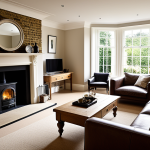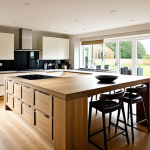Essential Pet-Proofing Strategies for UK Homes
Ensuring pet safety in UK homes begins with identifying and securing common household hazards. Items such as electrical cords, small objects, and cleaning products pose risks and should be kept out of pets’ reach. For instance, securing loose wires or using cord protectors can prevent chewing accidents that may cause injury or electrical shocks.
Preventing access to toxic plants and dangerous substances is equally important. Some common UK houseplants, like lilies, are highly toxic to cats and dogs. Storing chemicals, medicines, and detergents in locked cabinets or high shelves reduces the chance of accidental ingestion. Being aware of what plants and substances are harmful helps create a safer environment.
In the same genre : How can you balance aesthetics and functionality in UK home interiors?
When adapting homes, choosing pet-proof fixtures and fittings suited for various UK property types plays a key role. Durable door latches, secure window locks, and sturdy gates prevent pets from escaping or accessing unsafe areas. These adaptations offer peace of mind for pet owners in urban flats or rural houses alike.
By focusing on these strategies, pet owners can effectively reduce risks and tailor their homes to meet the specific needs of their furry companions.
Also to discover : What are the key features of a traditional UK home design?
Choosing Pet-Friendly Materials and Furniture
Selecting pet-friendly furniture UK involves prioritizing durable materials that withstand wear and tear while resisting stains. Fabrics such as leather, tightly woven microfiber, or treated canvas are excellent choices due to their robustness and ease of cleaning. These materials help maintain a home’s aesthetic without sacrificing functionality in a pet-friendly environment.
When it comes to flooring, pet-appropriate options should accommodate the UK’s often damp climate. Floors like sealed hardwood, tile, or vinyl offer easy-clean surfaces and resist moisture-related damage, essential for minimizing odors and maintaining hygiene in pet-occupied spaces. Carpets generally require more upkeep, and if chosen, should be stain-resistant varieties with a low pile to reduce dirt retention.
Maintaining pet-friendly furniture is straightforward with regular cleaning and protective treatments. Routine vacuuming and prompt stain removal prevent accumulation of dander and dirt. Using washable slipcovers or throws adds a further layer of protection, making maintenance less time-consuming and sustaining the furniture’s condition over time.
By carefully choosing materials that combine durability and practicality, pet owners can successfully create welcoming spaces suited to both their pets and household needs.
Creating Comfortable Zones for Pets
Creating dedicated indoor pet spaces enhances pet comfort by providing safe, familiar areas tailored to their needs. Designated sleeping zones with cozy beds or cushions offer pets a secure retreat. For play areas, allocate space with noise-absorbing mats or soft rugs to reduce stress from loud sounds commonly experienced in busy UK homes.
Ensuring warmth and shelter, especially during cold or damp UK seasons, is crucial for comfort. Placement of pet beds near radiators or in sunlit spots helps maintain a warm environment. Using insulated pet houses indoors can protect smaller or older pets sensitive to temperature changes.
Noise reduction strategies also support well-being, particularly for anxious pets. Adding soundproofing elements like curtains, rugs, or acoustic panels in their zones can minimize disruptive noises. These measures contribute to a calm atmosphere, promoting relaxation and reducing stress-related behaviors.
By focusing on these aspects, UK pet homes become more comfortable and accommodating, supporting pets’ physical and emotional health throughout the year.
Managing Outdoor Access and Garden Safety
Creating secure gardens is fundamental for outdoor pet protection in UK homes. Securing boundaries with sturdy, escape-proof fencing prevents pets from wandering off or accessing unsafe areas. For example, installing fences at least six feet high can deter agile dogs and climbing cats, while buried barriers reduce risks of digging escapes. Regular inspection and maintenance of gates and fence panels ensure ongoing security.
Choosing pet-safe gardens UK involves selecting plants that pose no toxicity risks to pets. Unlike toxic common species like foxglove or rhododendron, safer alternatives include lavender, rosemary, and camellias. These non-toxic plants reduce the danger of accidental ingestion while contributing to a pleasant garden environment. Pet owners should also avoid using chemical pesticides or fertilizers that could harm animals.
Weatherproofing outdoor areas supports year-round pet outdoor activity despite the UK’s variable climate. Providing shelters such as insulated dog houses or covered patios protects pets from rain and cold. Non-slip, durable surfaces like gravel or composite decking offer safe footing regardless of moisture. Additionally, shaded spots prevent overheating during warmer months, ensuring pets can enjoy outdoor access comfortably and safely.
By focusing on secure boundary controls, toxic-free planting, and weather-adapted outdoor spaces, pet owners can effectively safeguard their gardens for healthy and secure pet enjoyment.
Meeting Legal and Welfare Requirements for UK Pet Homes
Understanding UK pet regulations is essential for all pet owners to ensure compliance and promote pet welfare. Many tenancy agreements include specific clauses regarding pets, so reviewing home rental pet policies before moving is crucial. These policies can restrict the type, number, or size of pets allowed, and some landlords may require references or additional deposits to cover potential damage.
Meeting pet welfare standards involves providing appropriate care suited to each animal’s needs. This includes adequate space, proper nutrition, and regular veterinary check-ups. For dogs, welfare guidelines emphasize daily exercise routines and social interaction, while cats require stimulation and safe indoor environments. Smaller pets like rabbits or birds have unique habitat needs that must be accommodated in the home.
When handling special requirements or uncertainties, accessing professional advice can help ensure compliance and optimal care. Animal welfare organisations or veterinary professionals can offer guidance tailored to specific pets or situations. Staying informed about changes in UK pet regulations helps owners maintain safe, legal, and comfortable living environments for their animals.






